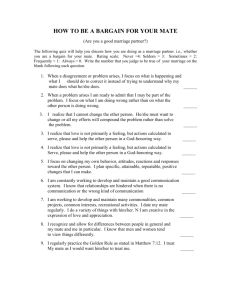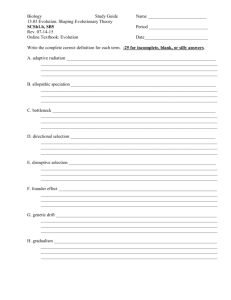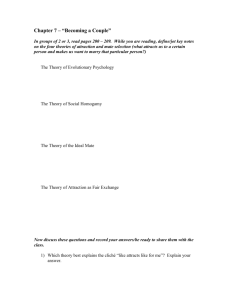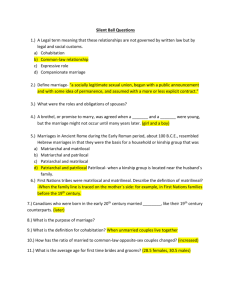When to get married: From individual mate search to population marriage patterns
advertisement
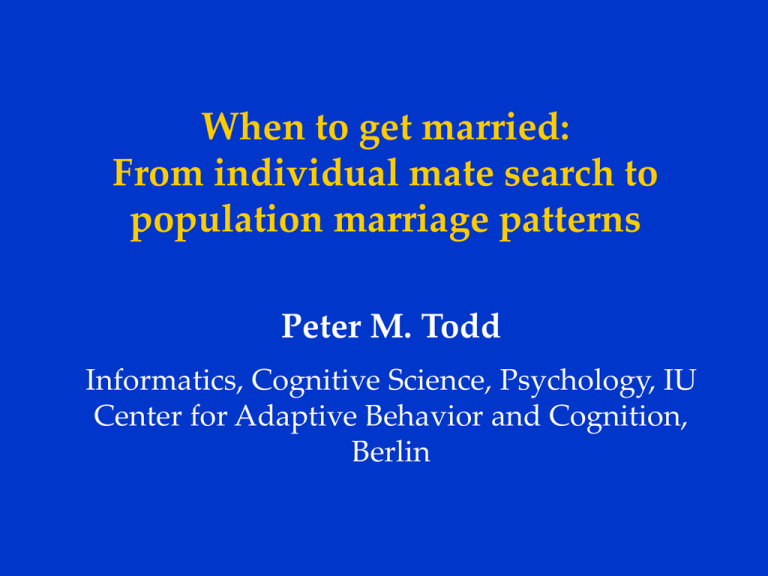
When to get married: From individual mate search to population marriage patterns Peter M. Todd Informatics, Cognitive Science, Psychology, IU Center for Adaptive Behavior and Cognition, Berlin Overview of the talk • The problem of sequential search • Sequential search in mate choice – One-sided search – Mutual search • Population-level (demographic) implications and test • Other sources of evidence The problem of finding things Search is required whenever resources are distributed in space or time, e.g.: • mates • friends • habitat • food • modern goods: houses, jobs, lightbulbs... Another better option could always arrive, so the real problem is: when to stop search? Choosing a mate Mate choice involves: 1. Assessing relevant cues of mate quality 2. Processing cues into judgment of mate quality 3. Searching a sequence of prospects and courting on the basis of judged quality Can be fast and frugal through limited cue use (steps 1, 2), and limited search among alternatives (step 3) Features of mate search No going back: once an alternative is passed, there’s little chance of returning to it No looking forward: upcoming range of possible alternatives is largely unknown How to decide when to stop? A well-studied “mate search” example: the Dowry Problem A sultan gives his wise man this challenge: • 100 women with unknown distribution of dowries will be seen • Women will pass by in sequence and announce their dowry • Search can be stopped at any time, but no returning to earlier women • Wise man must pick highest dowry or die How can the wise man maximize his chances of success and survival? Fast and frugal search Given a search situation with: • Unknown distribution of alternatives • No recall (returning to earlier options) • No switching (once a choice is made) then it can be appropriate to search using an aspiration level, or satisfice (Simon, 1955) Satisficing search Satisficing search operates in two phases: 1. Search through first set of alternatives to gather info and set aspiration level, typically at highest value seen 2. Search through further alternatives and stop when aspiration is exceeded But how long to search in first phase for setting the aspiration level? Solving the Dowry Problem Goal: Maximize chance of finding best option Approach: Set aspiration level by sampling a number of options that balances information gathered against risk of missed opportunity Solution: Sample N/e (= .368*N) In other words, the 37% Rule... The 37% Rule Search through options in two phases: Phase 1: Sample/assess first 37% of options, and set aspiration level at highest value seen Phase 2: Choose first option seen thereafter that has a value above the aspiration level Cognitive requirements are minimal: remember one value and compare to it An alternative criterion Seeking the optimum takes a long time (mean 74% of population) and doesn’t often succeed (mean 37% of times) Instead, a more reasonable criterion: maximize mean value of selected mates This can be achieved with much less search: check 9% of options instead of 37% in Phase 1 Take the Next Best rule: set aspiration after ~12 Maximizing mean value found Mean mate value vs. phase1 search, one-sided with no competition 100 Mean mate value selected 90 80 70 60 50 40 30 20 10 0 0 10 20 30 40 50 60 70 Length of phase1 search 80 90 100 More realistic mate search: Mutual choice Problem: Few of us are sultans Implication: • Mate choice is typically mutual Empirical manifestations: • most people find a mate... • who is somewhat matched in attractiveness and other qualities... • after a reasonably short search The Matching Game • Divide a class in half, red and green • Give each person in each half a number from 1 to N on their forehead • Tell people to pair up with the highest opposite-color number they can get Results: • rapid pairing • high correlation of values in each pair Modeling mutual search Kalick & Hamilton (1986): How does matching of mate values occur? Observed matching phenomenon need not come from matching process: • model agents seeking best possible mate also produced value matching within mated pairs • however, they took much longer to find mates than did agents seeking mates with values near their own Knowing one’s own value Some knowledge of one’s own mate value can speed up search But how to determine one’s own value in a fast and frugal way? Answer: learn one’s own value during an initial “dating” period and use this as aspiration level, as in to Phase 1 of satisficing search Mutual search learning strategies Methods for learning aspiration near own mate value, decreasingly self-centered: • Ignorant strategy: ignore own value and just go for best (one-sided search) • Vain strategy: adjust aspiration up with every offer, down with every rejection • Realistic strategy: adjust up with every higher offer, down with lower rejections • Clever strategy: adjust halfway up to every higher offer, halfway down to lower rejects Modeling mutual sequential mate search • Simulation with 100 males, 100 females • Mate values 1-100, perceived only by other sex • Each individual sequentially assesses the opposite-sex population in two phases: – Initial adolescent phase (making proposals/ rejections to set aspiration level) – Choice phase (making real proposals/rejections) • Mutual proposals during choice phase pair up (mate) and are removed How do different aspiration-setting rules operate, using info of mate values and offers? “Ignorant” aspiration-setting rule Ignore proposals/rejections from others-just set aspiration level to highest value see in adolescent phase Equivalent to one-sided search rule used in a two-sided search setting Everyone quickly gets very high aspirations, so few find mates... Ignorant rule’s mating rate Mean mated pairs vs. length of phase1 search, ignorant mutual search rule 100 Mean number of mated pairs 90 80 70 60 50 40 30 20 10 0 0 10 20 30 40 50 60 70 Length of phase1 search 80 90 100 Ignorant rule’s matching ability Mean within-pair mate value difference vs. length of phase1 search, ignorant mutual search rule 20 Mean within-pair mate value difference 18 16 14 12 10 8 6 4 2 0 0 10 20 30 40 50 60 70 Length of phase1 search 80 90 100 A better aspiration-setting rule Idea: use other’s proposals/rejections as indications of one’s own attractiveness, and hence where one should aim Adjust up/down rule: For each proposal from more-attractive individual, set aspiration up to their value For each rejection from less-attractive individual, set aspiration down to their value Adjust up/down rule’s mating rate Mean mated pairs vs. length of phase1 search, two mutual search rules 100 Mean number of mated pairs 90 Ignorant 80 Adjust up/down 70 60 50 40 30 20 10 0 0 10 20 30 40 50 60 70 Length of phase1 search 80 90 100 Adjust up/down rule’s matching Mean within-pair mate value difference vs. length of phase1 search, two mutual search rules 20 Mean within-pair mate value difference 18 16 Ignorant 14 Adjust up/down 12 10 8 6 4 2 0 0 10 20 30 40 50 60 70 Le ngth of phase 1 se arch 80 90 100 Comparing search learning rules Ignorant (one-sided) strategy forms unfeasibly high aspiration levels and consequently few mated pairs Adjust up/down strategy learns reasonable aspirations, so much of the population finds others with similar values (But still too few pairs are made, so other strategies should be explored) Summary so far—How others’ choices change mate search Solo mate search: set aspiration to highest value seen in small initial sample [Add indirect competition: decrease size of initial sample] Add mutual choice: set aspiration using values of proposers and rejecters in small sample Testing search rules empirically Difficult to observe individual sequential mate search processes “in nature” But we can see the population-level outcomes of these individual processes: the distribution of ages at which people get married Can we use this demographic data to constrain our models? Real age-at-marriage patterns Age-specific conditional probabilities of first marriage Age-specific conditional probabilities of first marriage 0.16 Prob(Marriage | Age) Norway Women, 1978 0.14 Romania Men, 1998 0.12 0.10 0.08 Romania Women, 1998 Norway Men, 1978 0.06 0.04 0.02 Norway Men, 1998 Norway Women, 1998 0.00 18 23 28 33 38 Age at first marriage 43 48 Explaining age at marriage Age-at-marriage patterns are surprisingly stable across cultures and eras (Coale) How to explain this regularity? • Latent-state models: people pass through states of differing marriageability • Diffusion models: people “catch the marriage bug” from other married people around them (cf. networks) Both can account for the observed data... Psychologically plausible accounts of age at marriage ...but neither latent-state nor diffusion models are particularly psychological Third type: search models • from economics: unrealistic fully-rational models with complete knowledge of available partner distribution • from psychology: bounded rational models using more plausible satisficing and aspiration-level-learning heuristics— which ones will work? One-sided searchers Francisco Billari’s model (2000): • Each individual searches their own set of 100 potential partners—one-sided, noncompetitive search • Take the Next Best: assess 12, then take next partner who’s above best of those 12 • Graph distribution of times taken to find an acceptable partner (as hazard rate)... Marriage pattern, one-sided model Can one-sided search be fixed? Monotonically-decreasing age-at-marriage distribution is unrealistic How can it be modified? Billari introduced two types of variation in learning period among individuals: • positively age-skewed (unrealistic?) • normally distributed around 12 Adding learning-time variability Mutual search with learning Previous model was unrealistic in being one-sided (ignoring own mate value) Does mutual search create the expected population-level outcome? • individuals start out with medium selfassessment and aspirations • individuals learn using “clever” rule, adjusting their aspiration partway up or down to mate value of offerer or rejecter Marriage pattern, mutual model 2 Fixing mutual learning search Introducing mutual search with learning is also not sufficient to produce realistic distribution of ages at marriage Again, adding variability in learning period (normal distribution) works... Adding learning-time variability Real age-at-marriage patterns Age-specific conditional probabilities of first marriage 0.16 Norway Women, 1978 0.14 Romania Men, 1998 0.12 0.10 0.08 Romania Women, 1998 Norway Men, 1978 0.06 0.04 0.02 Norway Men, 1998 Norway Women, 1998 0.00 18 23 28 33 38 43 48 Constraining search models with population-level data By comparing aggregate model outcomes with observed population-level data, we found: • one-sided search, mutual search, and aspiration learning alone were not able to produce realistic age-at-marriage patterns • adding individual variation in learning/ adolescence times did produce realistic patterns • other forms of variation (e.g., initial starting aspiration, distribution of mate values) did not help Another empirical approach Is there some way to observe the ongoing mate choice process on an individual basis? Mate choice in microcosm... FastDating ® How does FastDating work? • ~20 men and ~20 women gather in one room (after paying $30) • Women sit at tables, men move in circle • Each woman talks with each man for 5 min. • Both mark a card saying whether they want to meet the other ever again • Men shift to the next woman and repeat The rotation scheme W1 W2 W3 W4 M1 M2 M3 M4 W1 W2 W3 W4 M4 M1 M2 M3 t t+5 What happens next... • Men’s/women’s “offers” are compared • Every mutual offer gets notified by email, with other’s contact info • After that, it’s up to the pairs to decide what to do…. What we can observe Data we can get: offers made and received order in which people are met matches made --so (almost) like sequential search… (except for some fore-knowledge of distribution, and no control over when offers are actually made) So next summer we’ll run our own session: men and women kept separate, making decisions immediately after each meeting, and giving us full data about their traits and preferences New mate search models Individual variation in learning time is necessary But is a fixed period of learning followed by “real” search/offers very realistic? Newer model with Jorge Simão produces emergent variation: • Search using aspiration levels • Courtship occurs over extended period • Maintain a network of contacts and switch to better partners (if they agree) Can look at marriage age vs. mate value, distribution of ages, effect of sex ratio.... Age at marriage curves Finding a parking place One-sided parking search: • Sequence of filled/empty spaces seen one at a time • Can’t tell what’s coming up • Can’t turn around in the middle Differences from one-sided mate search: • Parking spaces get better as we go along • Can turn around at very end Driving/parking simulator Conclusions Sequential search heuristics use aspiration levels set in simple ways to stop search, trading off exploration against time/missed opportunities People use such heuristics in some domains, and may use them in mate choice Populations of simulated individuals searching for mates using simple search heuristics get married at times corresponding to the distribution of human marriages Empirical data supporting search heuristic use at the individual level is still needed (Fast-Dating) For more information... Todd, P.M., Billari, F.C., and Simão, J. (2005). Aggregate age-at-marriage patterns from individual mate-search heuristics. Demography, 42(3), 559-574. Simão, J., and Todd, P.M. (2003). Emergent patterns of mate choice in human populations. Artificial Life, 9, 403-417. Gigerenzer, Todd & the ABC Research Group (1999). Simple Heuristics That Make Us Smart. Oxford University Press. Me: pmtodd@indiana.edu The ABC group: www.mpib-berlin.mpg.de/abc Searching with other goals Maximizing chance of finding best option requires using 37% Rule But other adaptive goals can be satisfied with less search: Searching through about 10% of options in phase 1 and then setting aspiration level for further phase 2 search can produce good behavior on several goals Comparison of satisficing search Making things harder What happens when others join the search? 100 women searching through 100 men, each seeking something different This indirect competition forces faster search... Mate search with competition added Mean mate value vs. phase1 search, one-sided with and without competition Mean mate value selected 100 90 No comp 80 Indirect comp 70 60 50 40 30 20 10 0 0 10 20 30 40 50 60 70 Length of phase1 search 80 90 100 Earlier models of marriage age 0.4 Piecewise-constant rates 0.3 Hernes Log-logistic with immunity Coale-McNeil 0.2 0.1 0.0 15 20 25 30 35 Age 40 45 50 New mate search models Individual variation in learning time is necessary But is a fixed period of learning followed by “real” search/offers very realistic? Newer model with Jorge Simão produces emergent variation: • Search using aspiration levels • Courtship occurs over extended period • Maintain a network of contacts and switch to better partners (if they agree) Can look at marriage age vs. mate value, distribution of ages, effect of sex ratio.... Mating time related to quality Mating time vs. sex ratio (female/male sex ratio) Mate quality vs. sex ratio (female/male sex ratio)
